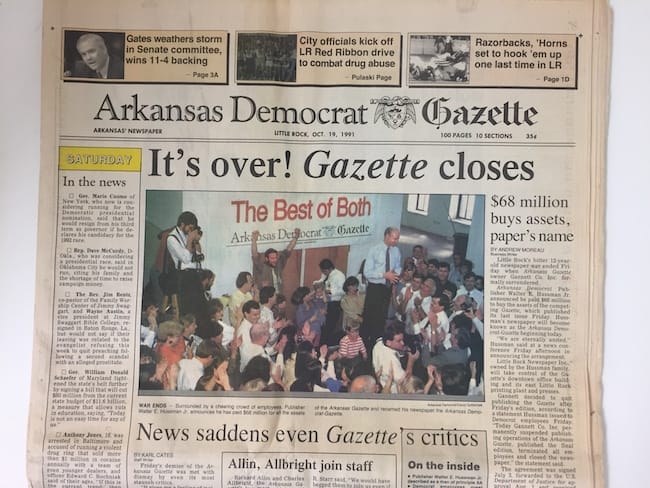

Uh oh...
It appears that you're using a severely outdated version of Safari on Windows. Many features won't work correctly, and functionality can't be guaranteed. Please try viewing this website in Edge, Mozilla, Chrome, or another modern browser. Sorry for any inconvenience this may have caused!
Read More about this safari issue.

The lively and tumultuous history of the Arkansas Democrat-Gazette began in the 1800s with the publication of the newspaper’s first edition before Arkansas had even attained statehood. By the time the century turned, a competing paper had emerged, along with petulant exchanges, name-calling and a gunfight, launching the two state newspapers onto rocky battleground for the next 170 years.
A Little History
The Arkansas Gazette, the state’s first newspaper, started in 1819 by William E. Woodruff, who worked as a journeymen printer in a few states before landing in Arkansas. Leading up to the Civil War, the newspaper changed hands and partnerships. It closed temporarily in the 1860s to perils of the war when federal authorities commandeered its presses.
During Reconstruction, another newspaper began, also going through a variety of editors and owners as well as several names, including The Liberal, The Journal and The Evening Star. When Colonel J.N. Smithee purchased it in 1878, the publication became the Arkansas Democrat.
The nation’s war ended, but the battle between the state’s two newspapers was firing up. Smithee criticized the Arkansas Gazette for its position on state issues. The Gazette countered and made claims against the Democrat that its name was a cover for the Republican Party.
Two newspapermen took their fight to the street. At the intersection of Markham and Main in Little Rock, the resulting gunbattle between Smithee and one of the Gazette’s owners, Major John Adams was a perfect metaphor for the forthcoming century-long sparring between the newspapers.

Each newspaper’s ownership continued to change numerous times. In 1902, the Heiskell family purchased The Gazette, modernized the presses and started printing news seven days a week. By the start of World War II in 1939, with newspapers still more popular than radio as the primary source of news, the Gazette, prepared with a staff of qualified news reporters and a fast printing press, was equipped to print war photos and bring the drama of the war’s progress to readers.

Taking a Stand
In 1957, when race relations and the issue of desegregation reached a climax, Gazette executive editor Harry Ashmore took a risky editorial position with a front-page piece.
That was the year student Elizabeth Eckford walked with determination to the entrance of Little Rock Central High School. The newspaper photographs of angry crowds screaming at her became a visual representation of the fight over black students admitted to all-white schools. Eckford was blocked at the door at the direction of Arkansas Gov. Orval Faubus, who was defying a federal court order. Ashmore’s admonishment of the governor and the responsibility of reporting on a controversy affecting the whole country energized the Gazette newsroom.
Under the anxiety and tension of the political and social turmoil, Gazette reporters remained focused. Leading up to and during the admitting of the Little Rock Nine to the high school, the eyes of the country were watching. Arkansas news became national news.
Even as its reporters were sought by other publications, the Gazette, having gained a great national reputation and ability to maintain high standards, was able to recruit reporters from around the country to replace staff that moved on. The Arkansas Gazette had set high literary standards, benefiting the reporters who were leaving, and those who were coming in.

In 1958, the paper won the Pulitzer Prize for Public Service, and Ashmore won the Pulitzer for Distinguished Editorial Writing.
But neither Gazette’s moral conscience, nor extraordinary writing could save it from another angry mob. Unapologetic in its unpopular stance in support of desegregation, the newspaper paid a price. The stories captured national attention but angered many Arkansas residents. Canceled subscriptions cost the paper millions of dollars as its circulation plummeted.
The Arkansas Democrat only briefly gained popularity because of the initial outrage against the Gazette during desegregation. When Walter Hussman purchased the Democrat in 1974, he again worked to increase circulation. He wanted to make it a better newspaper, taking on the challenge of running against the rival Gazette. But as time created space from the desegregation controversy, the Gazette began to recover its readership.
The Lawsuit
The Democrat again made changes to try and become a valid competitor. The paper went after businesses advertising in the Gazette by offering lower rates and printed classified ads for free. When John Robert Starr became managing editor in 1979, he guided the Democrat as it became the fastest growing newspaper in the country. When it finally turned a profit, the Democrat distributed the money among employees and gained an edge over the Gazette.

Steve Whelchel lived in Arkansas from 1962-1982, and again during the 1990s. He recalls the heavy competition between the newspapers and the significance of the Democrat’s free classified ads.
“The biggest thing that got them started growing was the free want ads, which was unheard of. If you needed to sell or buy something used, especially cars, you bought the Sunday Democrat. That generated tons of circulation growth for them. When I was grown and moved away, they were still separate, but the Gazette had weakened. I think they finally relented to the free want ads, but by then the Democrat had too much momentum.”
The Gazette fought back with additional staff, a color newspaper and a lawsuit against the Democrat for unfair business practices. The Gazette lost. To keep from folding, and in light staff layoffs, the newspaper unwittingly began its demise when it sold to the Gannett Corporation in 1986.
Gannett, a large newspaper chain, made mistakes in trying to keep the local publication afloat. Dillard’s pulled advertising after finding out they were charged more than other businesses. Staff members criticized the Gannett leadership for incompetence in putting out a serious state newspaper and for tactics that turned away readers, irritated writers and other employees and resulted in a news publication of lesser quality.
Nearly 172 years after its birth, to prevent it from completely closing, the Gazette sold to rival Arkansas Democrat in 1991. Many people believed that the Gazette hadn’t so much partnered with a competitor to create a new publication, as much as it had simply ceased to exist altogether.

Amanda Horn was an Arkansas resident from 1983 to 2017. She studied in elementary school about the Gazette and remembers the emotion of the adults around here when it sold. “I remember learning about it in Arkansas history because it was one of the oldest newspapers west of the Mississippi. And I remember a lot of people being upset because they felt a newspaper they trusted merged with one they didn’t.”
Today, the Arkansas Democrat-Gazette is the only statewide newspaper. With print and digital editions covering stories in regions across the state and numerous features throughout the week, it brings news to the front door to thousands of residents. Brought to the present in spite of a turbulent and competitive past, the newspaper now has the future challenge of remaining relevant to readers who have an overwhelming number of options for daily news.
Sources:
AETN/Arkansas IDEAS videos: “Historical Perspective,” “Desegregation in Arkansas,” “New Competition,” “End of the Gazette,” Kevin Clark, Dr. Donna Lampkin Stephens The Encyclopedia of Arkansas History & Culture, The Central Arkansas Library System, Mary L. Kwas, Arkansas Archeological Survey, 2016
Community Diaries: Arkansas Newspapering, Michael B. Dougan, August House Publishers, Little Rock, 2003
Pulitzer.org
NPR.org
Join the Conversation
Leave a Comment
4 responses to “Dueling News: History of the Arkansas Democrat-Gazette”
 Leave a Reply
Leave a Reply
We do the work.
You check your email.
Sign up for our weekly e-news.
Get stories sent straight to your inbox!












 Leave a Reply
Leave a Reply
[…] good, in fact, it led the Arkansas Gazette to write the following in its Feb. 3, 1841 […]
[…] May 1970, the Arkansas Gazette (now the Arkansas Democrat-Gazette) reported that Big Arkie was refusing food and that his health was deteriorating. Despite the […]
[…] of the Civil Rights Movement that gripped the nation. After his internship, Mitchell joined the Arkansas Democrat in 1982 before moving to the Hot Springs Sentinel-Record in 1983. It was with the Sentinel-Record […]
[…] pandemic, fearing widespread panic. Instead, they downplayed the spread. An October issue of the Arkansas Gazette wrote, “Spanish influenza is plain la grippe — same old fever and […]